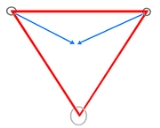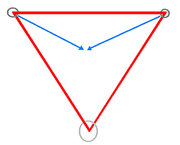
American death triangle
Encyclopedia
The American Death Triangle, also known as the "American Triangle", "Death Triangle" or "Triangle Anchor" is a type of rock climbing
anchor
infamous for being a poor anchoring technique due to both the way the forces of the load are magnified on the fixed anchors and the lack of redundancy in the cord.
s: one at each fixed point and one at the "focal point" or where the load is going to be attached to the system. The goal is to distribute the force of the load so that each fixed point takes a portion (ideally an equal portion) of it. The anchor is formed by clipping a piece of webbing
or cord through each of the carabiners in turn. The resulting triangle shape gives the anchor its name.
The force on each fixed point depends on the angle at the focal point. In the following table the percentage of the load's force that is transferred to the fixed point is listed at each focal point angle, and the same percentage is presented for the standard "V" shaped anchor.

These values are derived from the vector analysis
.
In both cases there is the same amount of tension in the sling. For the V arrangement, the anchor force is equal to the tension in the sling, but for the triangle the anchor force is greater than the sling tension.
Aside from the magnification of forces, the death triangle violates several rules of thumb for building rock climbing anchors, such as
An alternate bad form of anchor that has also been called the American Triangle involves using a single loop of cord that passes through two anchors and a carabiner, but the carabiner is not topologically bound to the cord. The correct method involves putting a twist in the cord as it goes through the carabiner, so that if an anchor fails, the carabiner will not slide off the cord.
There are situations where a climber may want to use this technique, but they are rare and require an expert to evaluate whether it is warranted. In summary, in a situation where the climber needs opposing forces to either keep passive chocks
, camming devices, or spring-loaded camming devices in a certain orientation (i.e.: a crack), they may elect to rig a triangle to create the opposing forces necessary to keep the protection
in the correct orientation. Even then, special provision must be made to provide redundancy and eliminate extension.
Rock climbing
Rock climbing also lightly called 'The Gravity Game', is a sport in which participants climb up, down or across natural rock formations or artificial rock walls. The goal is to reach the summit of a formation or the endpoint of a pre-defined route without falling...
anchor
Anchor (climbing)
In rock climbing, an anchor can be any way of attaching the climber, the rope, or a load to rock, ice, steep dirt, or a building by either permanent or temporary means...
infamous for being a poor anchoring technique due to both the way the forces of the load are magnified on the fixed anchors and the lack of redundancy in the cord.
Description
In a two-point climbing anchor, there are three carabinerCarabiner
A carabiner or karabiner is a metal loop with a sprung or screwed gate that is used to quickly and reversibly connect components in safety-critical systems. The word comes from "Karabinerhaken", meaning "hook for a carbine" in German.-Use:...
s: one at each fixed point and one at the "focal point" or where the load is going to be attached to the system. The goal is to distribute the force of the load so that each fixed point takes a portion (ideally an equal portion) of it. The anchor is formed by clipping a piece of webbing
Webbing
Webbing is a strong fabric woven as a flat strip or tube of varying width and fibres often used in place of rope. The name webbing comes from the meshed material frequently used in its construction, which resembles a web...
or cord through each of the carabiners in turn. The resulting triangle shape gives the anchor its name.
The force on each fixed point depends on the angle at the focal point. In the following table the percentage of the load's force that is transferred to the fixed point is listed at each focal point angle, and the same percentage is presented for the standard "V" shaped anchor.

| Bottom angle | Load per anchor (V arrangement) | Load per anchor (triangle arrangement) |
|---|---|---|
| 0° | 50 lbf | 71 lbf (not physically possible) |
| 5° | 50 lbf | 72 lbf |
| 10° | 50 lbf | 74 lbf |
| 30° | 52 lbf | 82 lbf |
| 60° | 58 lbf | 100 lbf |
| 90° | 71 lbf | 131 lbf |
| 120° | 100 lbf | 193 lbf |
| 150° | 193 lbf | 380 lbf |
These values are derived from the vector analysis
Parallelogram of force
The parallelogram of forces is a method for solving the results of applying two forces to an object. When more than two forces are involved, the geometry is no longer parallelogrammatic, but the same principles apply...
.
- For a V arrangement,

- For the Triangle,

In both cases there is the same amount of tension in the sling. For the V arrangement, the anchor force is equal to the tension in the sling, but for the triangle the anchor force is greater than the sling tension.
Aside from the magnification of forces, the death triangle violates several rules of thumb for building rock climbing anchors, such as
- redundancy: if the webbing fails on one leg of the anchor, the entire anchor will fail.
- extension: if one of the anchors fails, the webbing will greatly extend and will shock load the remaining components of the system
An alternate bad form of anchor that has also been called the American Triangle involves using a single loop of cord that passes through two anchors and a carabiner, but the carabiner is not topologically bound to the cord. The correct method involves putting a twist in the cord as it goes through the carabiner, so that if an anchor fails, the carabiner will not slide off the cord.
There are situations where a climber may want to use this technique, but they are rare and require an expert to evaluate whether it is warranted. In summary, in a situation where the climber needs opposing forces to either keep passive chocks
Nut (climbing)
In rock climbing, a nut is a metal wedge threaded on a wire, used for protection by wedging it into a crack in the rock. Quickdraws are clipped to the nut wire by the ascending climber and the rope threads through the quickdraw. Nuts come in a variety of sizes and styles, and several different...
, camming devices, or spring-loaded camming devices in a certain orientation (i.e.: a crack), they may elect to rig a triangle to create the opposing forces necessary to keep the protection
Protection (climbing)
To make climbing as safe as possible, most climbers use protection, a term used to describe the equipment used to prevent injury to themselves and others.-Types of climbing:...
in the correct orientation. Even then, special provision must be made to provide redundancy and eliminate extension.
External links
- Climbing Anchor
- Climbing Anchors includes photo

